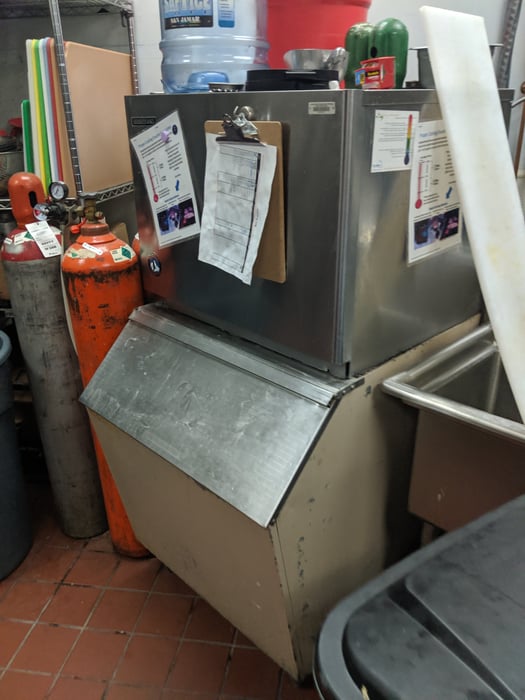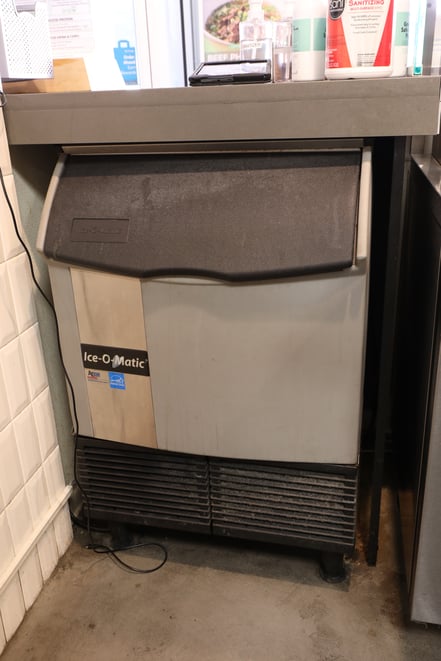Welcome to another 86 Repairs Guide! In this series, we provide valuable troubleshooting, preventative maintenance, and warranty information on the equipment and infrastructure found in your restaurant. We hope this information will help you and your team become more informed about repairs and maintenance (R&M)—and save you time and money along the way.
This guide to restaurant ice machines is brought to you by our partner, Easy Ice.
“Don’t leave the scoop in the ice!”
“Close the bin door!”
“Scoop from the back!”
“We need more ice in the well!”
Anyone who’s worked in the restaurant industry probably hears these ice machine-related refrains in their sleep. You may have scooped a thousand buckets of ice, but have you ever thought about what actually keeps the ice maker running? Most people don’t—the ice is simply there when they want it...
...Until it’s not. Interest in ice spikes when the supply looks different or stops altogether. Suddenly, it's all hands on deck as people scramble to get the machine fixed.
Imagine going to a bar that didn’t have ice: would your martini be worth drinking if it wasn’t shaken? And a lukewarm bottle of water just won’t hit the same for customers who are craving ice-cold Diet Coke. Follow these nuggets of ice machine maintenance tips to avoid issues in the first place. Keep reading to find out more.
Table of Contents

What is a restaurant ice machine?
Restaurant ice machines seem simple from the outside. Most of them consist of the machine sitting on top of an ice storage bin, though some ice makers are placed on drink dispensers. But inside the ice machine? There’s a complex network of components that must function seamlessly to automatically produce hundreds of pounds of ice each day.
Inside an ice maker, refrigerant is the hero of the ice-making process. It circulates through four components—the compressor, the condenser, the expansion valve, and the evaporator—changing states of matter as it heats and cools.
- At the evaporator, the liquid refrigerant’s low temperature draws the heat from incoming water causing it to freeze onto the evaporator.
- Then, the compressor heats the refrigerant into a vapor, sending it through the expansion valve. The compressor steps in to cool the refrigerant back into a liquid, expel the heat from the ice maker, and prepare the refrigerant to cool more water into ice.
- Finally, the ice machine uses either hot gas or room temperature water to warm the evaporator enough for the ice to release and drop into the ice bin.
For the unit to function properly, its environment must be set up correctly when installed. During installation, the ice maker should be hooked up with proper drain, electricity, water, and space requirements. Many equipment retailers aren’t aware of ice machine requirements and don’t educate restaurant owners on how to prepare the environment. This is a recipe for failure.
The biggest hurdle to ice machine function is heat. Hot water and hot ambient environments work against ice makers. For best results, install in rooms that are close to 70 degrees Fahrenheit and get water around 50 degrees Fahrenheit.
Installing ice makers in closets or in spaces without proper ventilation or placing them near heat-generating equipment like ovens can create hot microclimates that cause reduced ice production, small or misshapen cubes, and ultimately, unnecessary repairs.
How much should restaurant owners and operators expect to spend on ice machine repairs? Let’s take a look.
Numbers to know about restaurant ice machines
Commercial ice machines vary in price from $2,000 to $27,000. But high costs don’t end with the purchase price. From small repairs and expensive component replacements to cleaning, restaurant ice machine care costs can quickly add up. According to The State of Repairs:
- The average cost to repair an ice machine in 2021 was $708.44.
- The first-time fix rate (FTFR) for all cold-side equipment in 2021 was 85.6%. That means that, for units like ice machines, vendors had to be dispatched to fix the same problem almost 15% of the time.
Although the best-maintained ice machines will still break down at some point, using preventative maintenance and troubleshooting tips can help restaurant owners cut back on unnecessary expenses and downtime.

Preventative maintenance for restaurant ice machines
Make sure the unit is set up for success. Be sure staff fills all ice machine wells at the beginning and end of each shift to make the most of ice production to avoid assumptions that the unit isn’t working properly.
Ice machine manufacturers recommend at least two preventive maintenance and deep cleaning visits per year. More may be needed if the ice machine is installed in a suboptimal environment, such as a bakery or brewery where airborne contaminants need to be removed from the ice maker more frequently.
During routine preventive maintenance, the ice machine technician will check for any small leaks or water damage. This enables them to remedy a lesser issue before it becomes a major one.
The technician will perform numerous maintenance tasks, including but not limited to:
- Wiping down the compressor compartment
- Checking the water pump/regulator (for water-cooled units)
- Inspecting the control box
- Clearing ice from the evaporator plate and inspecting for damage
- Running a production check
- Cleaning air condenser and air filters (for air-cooled units)
Note that, although filters will be checked during the appointment, they should be cleaned at least every two weeks. For environments with a lot of airborne contaminants like flour, yeast, and grease, they should be cleaned even more frequently.
In addition to maintenance items, the technician will descale, disinfect, and sanitize all parts of the machine and bin that touch water or ice during production. This extensive, three-part deep cleaning process is critical to the ice maker’s short- and long-term function as well as the safety of the ice.
Deep cleaning rids the ice machine of unwanted substances like scale, algae, and grime. Deep cleanings should be performed at least twice a year—and more often for environments with extensive airborne contaminants. Failure to deep clean a commercial ice maker can result in buildup, which jeopardizes the production of the machine and can result in dirty, cloudy, or unsanitary ice.
Restaurant ice machine troubleshooting tips
Ice not looking so nice? Before you call your ice maker technician, try these troubleshooting tips to see if they resolve your issue:
Check the basics
- Is the unit plugged in?
- Is the breaker turned on?
- Has there been any water interruption?
Check the environment
- Is the ambient temperature below 90 degrees?
- Is the water temperature around 50 degrees?
- Is there a 12-inch space on all sides and above the ice maker?
Check the consumption
- Often, restaurant operators think their ice machines aren’t producing enough when, instead, demand has just increased.
- Were more tables added at the restaurant, or was it unexpectedly busy?
- Did you host a big event or party?
Check the air filter
- Is the airflow blocked by grease, yeast, other contaminants, or an object pressed against it? This can cause the ice machine to slow or shut down entirely.
If the basics are in place, the environment is right, consumption is standard, and the air filter is clear, but production issues persist, it’s time to contact your ice maker technician. The technician may ask you to:
Relay the ice maker's error code
- If the machine is giving an error code, pay attention to its patterns. These are important to determine what’s actually wrong.
- Manitowoc, Hoshizaki, and other brands of ice makers have unique notifications, so be sure to note your machine’s brand, model, and code or number of beeps when calling for a repair.
- Check for a puddle formed under the ice maker. This could signify a leak from the water lines or within the ice machine itself.
- If the leak is coming from the ice maker, shut down the machine right away and call your ice maker technician for a closer look.
- If the water line is leaking, unplug the ice maker before shutting off the water. Then, call a plumber to repair the line.
Unfortunately, some problems signal the end of an ice maker’s life. Here are some of the signs an ice machine needs to be replaced.

Restaurant ice machine parts and warranties
Restaurant ice maker parts in need of frequent repair or replacement are usually water-related. Any part that comes into frequent contact with water has the potential for scale buildup —especially in regions of the U.S. with hard water.
That buildup can jam up the components that make the unit run properly, like float switches, relays controlling water flow, water level sensors, and water pumps. Luckily, scale buildup is easy to remedy with professional ice maker care.
Some of the pricier parts to repair in an ice maker include evaporators (known as an evaporator chamber in nugget and flake ice makers), condensers, and compressors. Learn more about what can go wrong with these ice maker components here.
Before performing any preventative maintenance or troubleshooting yourself, double-check your warranty to ensure your actions won’t accidentally invalidate the agreement.
A final note on restaurant ice machines
On paper, ice is easy. After all, it’s only frozen water. But making ice at scale is complicated and can get expensive fast. Let’s face it: without ice, restaurants can’t serve customers the cold beverages they crave.
When an ice machine breaks down, restaurant operators and staff can spend hours finding qualified providers, scheduling, and replacing ice. It’s valuable time spent away from customers and day-to-day operations that keep the business running.
This guide is brought to you by our partner, Easy Ice.
An Easy Ice subscription is exactly as it sounds – easy! Subscription customers have the ice they need, guaranteed. Easy Ice will install a top-quality ice maker in your restaurant, then handle all preventive maintenance, deep cleaning, repairs, and backup ice from there.
When a reliable supply of clean, clear ice is the goal, Easy Ice is the best choice. Learn more about all-inclusive Easy Ice subscriptions here.